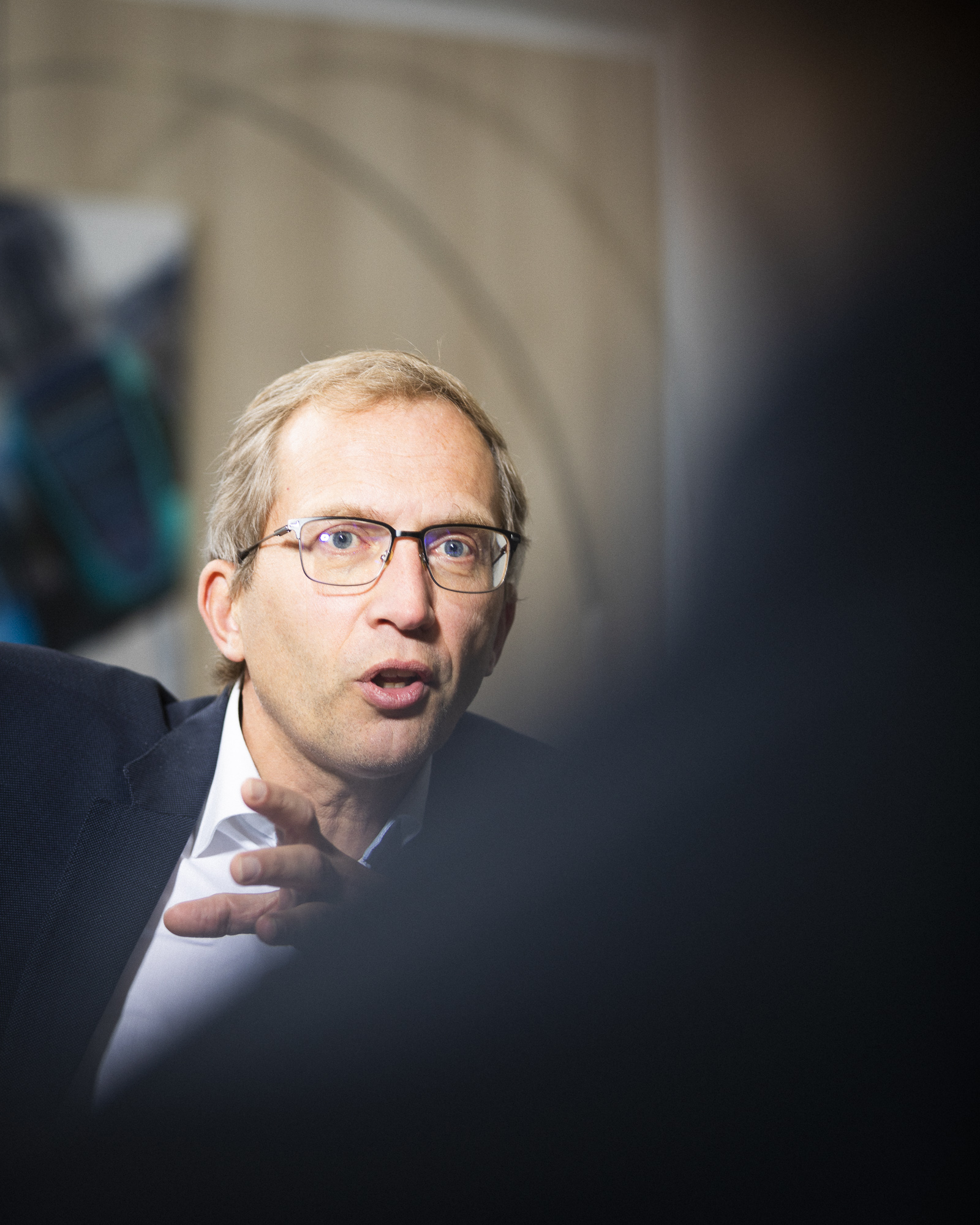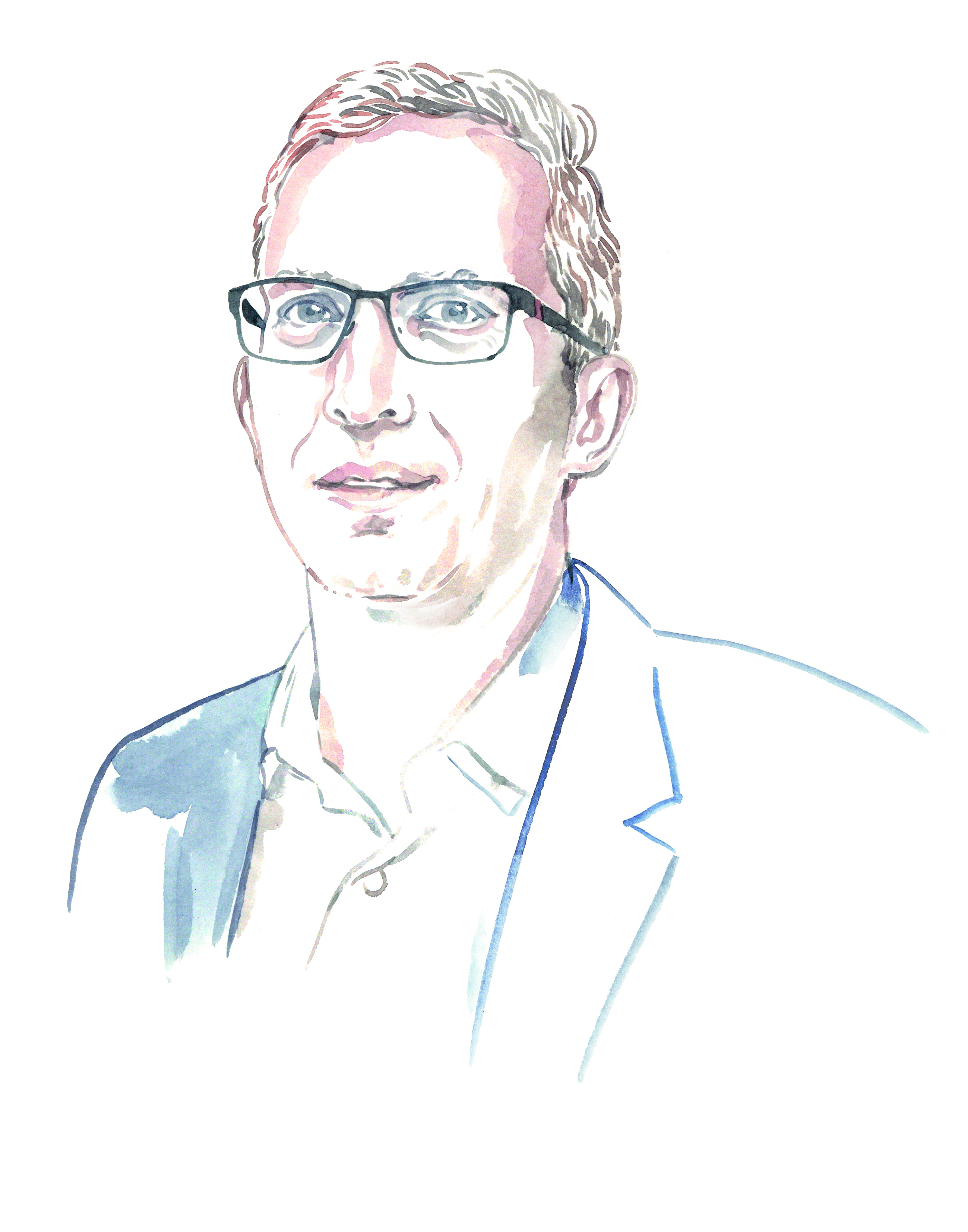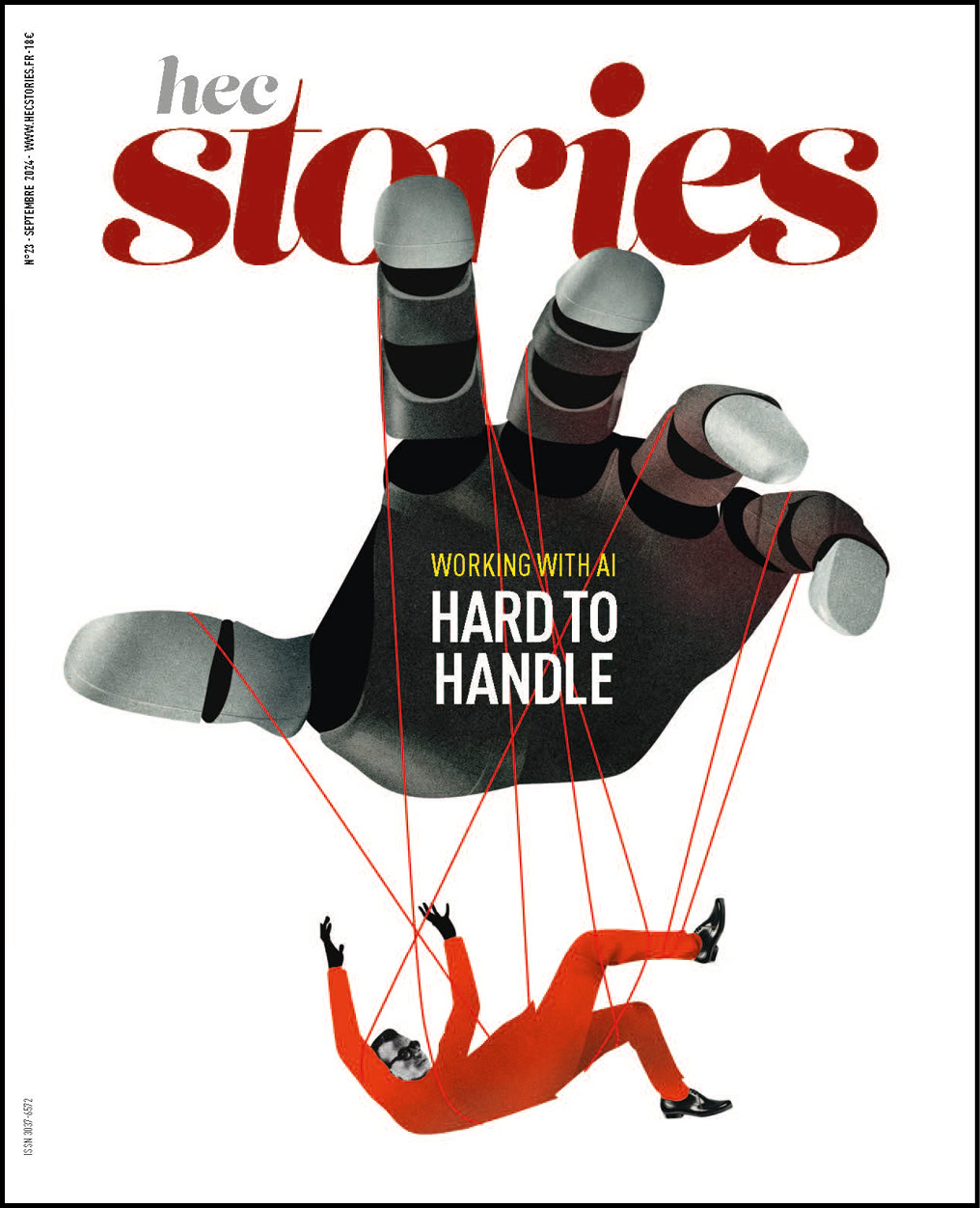Three HEC students interview Alstom CEO Henri Poupart-Lafarge

Alstom has dramatically transformed itself. Those words are not too strong to describe the change that the French rolling stock manufacturer has undergone in the past decade. In 2014, the group was on the verge of collapsing. It had to pay a record 772 million dollar fine in the United States over cases of corruption. The same year, it sold its energy business to GE. Five years later, the attempted merger with German competitor Siemens, which was expected to create a European champion capable of facing Chinese giant CRRC, was rejected by the EU Commission. Officials feared a drop in competition that would have affected its customers, namely railway companies.
Henri Poupart-Lafarge has been the chairman and CEO of Alstom since 2016. Under his leadership, the multinational company has been back on track. Two years ago, the acquisition of its Canadian rival Bombardier doubled the size of the group. It is now #2 in the world behind CRRC. Turnover is close to 15.5 billion euros and order book recently reached a record, close to 86 billion euros. The rail industry is driven by energy transition. Train and tramway projects are multiplying on both sides of the Atlantic, but also in Australia and Saudi Arabia. The French SNCF’s record-breaking summer is an illustration of the renewed interest for rail.
A few days after celebrating his 25 years at Alstom, Henri Poupart-Lafarge met with three students from HEC Paris at the company’s headquarters near Paris. During one full hour, the 53-year-old boss gave his vision of the industry and boasted the assets of his group, whose new TGV M will consume 20% less electricity. Warm, straight to the point, Poupart-Lafarge displays a certain skepticism toward disruptive projects of magnetic levitation trains like Hyperloop. The low-key manager, who was approached to replace Jean-Bernard Lévy at the head of French electricity giant EDF, also shared his view on corporate leadership. An inspirational meeting.
My name is Shailja and I’m doing my MBA at HEC right now, specializing in strategy. Before that, I was working with Alstom.
H.P-L: Great. Where exactly were you working?
Shailja: I was in India and worked as a validation engineer for the Sydney Metro. Then, I moved to Bangalore to work on bids for rolling stock in train validation. I also set up the train lab for Smart metro.
H P-L: Excellent. You have already a very diversified experience! Welcome back!
Shailja : It’s a real pleasure. I feel nostalgic about my first experience with Alstom. I started there as a young graduate. Alstom came to my campus to hire young engineering graduates through the Yeg program. I am the only student from the railway industry in my MBA. The last time I saw you was in 2018, in the Bangalore office.
H P-L: We now have close to 10,000 employees in India – almost as many as in France. We have our largest engineering center there, with a large number of talents. You should join again!
Shailja : I’ll come back with stronger skills!
Rail transport driven by the ecological transition
Paul: We have some questions for you. Let’s start with the big picture. With the rise of environmental concerns and Joe Biden’s massive climate investment plan, has the rail industry entered a new golden age?
H P-L: Environmental transition is a fundamental driver of our market. Transportation accounts for 27% of global CO2 emissions and could go up as high as 40%. In the last 15 to 20 years, transportation systems have increased their carbon emissions, while all other types of activities like energy and agriculture have decreased them. This rise of consciousness that mobility can be a solution to fight against climate change is fairly recent. During the 2015 United Nations Climate Change Conference in Paris, I remember that all speeches focused on energy.
Not a single word was said on transportation! Indeed, for decades, the railway market was pushed by urban, economic and population growth– typically in India and China where new cities have arisen. India is a good example : 42 cities have got metro projects. As you know, the US and Europe have now launched massive infrastructure plans to decarbonize mobility. These are two-part deals : first, shifting the model by transitioning from plane and car to train and then make trains more energy efficient.
Paul: How do you deal with that?
H P-L: Most of our effort is put on the 95% of our trains that are already electrified. For example, our new generation of high-speed trains consumes 20% less energy and has 20% more seats than previous generations – which reduces energy consumption by about a third per seat. Regarding the remaining 5% of trains which are still fueled by diesel, we need to find alternatives. We developed battery-powered trains and we have been pioneers in designing hydrogen trains in Germany. We have projects in France, Italy and other countries. It is extremely promising.
Shailja: Covid-19 has forced railways to introduce hygiene measures, limit coach occupancy, facilitate contactless payment and so on. How has the pandemic changed (or not) your vision for the train of the future?
H P-L: This is a good question. The pandemic has accelerated some trends in terms of hygiene measures in public transports. Our innovation teams have worked to implement healthier mobility solutions for our metros and trains. For example, antiviral tissues for seats, contactless doors or items to prevent people from touching the poles in the metro.
Shailja: I guess remote working impacts your markets…
H P-L: Definitely. We have noticed that travel habits have changed with remote working. For example, the peak frequentation has decreased in metros because more people travel to work off peak. But worldwide the impact varies from an area to another. In Asia, office work is back to pre-pandemic levels. In Europe, we are at 80-85%. It is much lower in the USA, especially in California – around 30%.
Shailja: The impact also depends on the the of jobs employees have. People who don’t have remote working possibilities are coming back to trains.
H P-L: People now can decide where they want to live, depending on how often they need to go to the office. In France, for example, employees who work in Paris but who just need to come to the office twice a week can decide to move to Bordeaux, two hours away from Paris by train. Before the pandemic, they had to pick cities within commutable distance to the capital. This applies of course for those who can work remotely. In that respect, it is interesting to notice that in Paris, suburban trains going to offices areas like La Défense have a lower ridership than those bringing people to more industrial areas.
 Henri Poupart-Lafarge, PDG d’Alstom, lors d’une interview avec trois étudiants de HEC, pour le magazine HEC Stories. Photo © Ed Alcock / MYOP 23/2/2023
Henri Poupart-Lafarge, PDG d’Alstom, lors d’une interview avec trois étudiants de HEC, pour le magazine HEC Stories. Photo © Ed Alcock / MYOP 23/2/2023
Paul: Do you fear competition in Europe from Chinese CRRC, the global industry leader? H P-L:
H P-L: I am not focused on one competitor more than another. Alstom is the only global player in the industry and the most important thing for us is to keep being disruptive and lead the market in terms of innovation. Our activity is split almost evenly between rolling stock and other activities, in particular digital activities, on a worldwide basis. We have a unique footprint from Australia to North America, including Europe and South-East Asia where we always face local actors.
Paul: I read that CRRC is preparing a magnetic levitation train (maglev) capable of running at 600km/h. H P-L:
H P-L: When it comes to the future of technology, I strongly believe that the bulk of the market will remain trains as we know them already. However, trains will be much more energy efficient and connected with an improved passenger experience.
Paul: What about maglev trains?
H P-L: We are always looking at new initiatives with interest on the market, but I believe this will remain a niche. It is overly complex to implement because you need to operate the train on a ground that is completely flat and requires a lot of energy and infrastructure.
Shailja: Can you discuss any initiatives Alstom has put in place to promote diversity and inclusion in the workplace at an executive level and aboard its trains?
H P-L: Diversity and inclusion are of critical importance at Alstom. First internally, as a global company, so everyone can collaborate with their colleagues around the planet, and everybody feels welcome, safe, and fulfilled in their daily work. Most initiatives are local. For instance, our teams implemented solutions in sensitive areas to make sure our female talents could go back home safely at night. Then, our mobility solutions also need to be inclusive, especially for passengers with disabilities or people with reduced mobility. As an illustration, our teams work with associations on solutions for visually impaired people to be directed in the trains or for deaf people to know when the train is arriving.
The new Alstom: a group with a record order book
Eliott: A rescue plan in 2003, the sale of the energy business to GE in 2014 and a failed merger with Siemens in 2019… Alstom has had some tough time. Has the group managed to restore its reputation?
H P-L: When I joined Alstom 25 years ago, the company was organized in six divisions including shipyards in Saint-Nazaire, transformers, switch gears, power plants… Today, we have become a world leader in rail transportation, with approximately the same level of global turnover (editor’s note: 15.5 billion euros). I’m convinced that the choice of transportation was the right one to make. It’s a choice towards a nice future as we said earlier, and with many innovations to bring in the years to come.
Paul: How did you experience the failed merger with Siemens? Four years later, what is your analysis of the anti-competitive authorities rejecting a merger between two big European companies?
H P-L: European authorities considered that the two firms would be too dominant together. But this is behind us and, since then, I’m very proud that we have acquired the Canadian company Bombardier Transport, which gave us a truly global size.
Paul: Regarding Bombardier, how is the integration going? Two years later, what is your assessment of the acquisition?
H P-L: At the time of the acquisition, I would say that the integration will take three to four years. We are in line with this trajectory. We had a clear plan with three phases. The first one was stabilization. We spent the first two years stabilizing the project portfolio of Bombardier legacy and restoring good customer relationships. It is past us now. The current phase is dedicated to efficiency and quality control. Some projects were facing execution issues. After that, we can fully leverage our global reach and concentrate on innovation, which really is the ultimate goal.
Paul: How?
H P-L: By leveraging our global footprint, which is extremely good for innovation. We can cross-check what is being required by customers in Australia, India, the US, Europe, etc. We can take ideas from different markets and bring fresh solutions. Our footprint in Germany, for instance, allowed us to present the first passenger train powered by hydrogen fuel cells.
Eliott: What are the main levers to set Alstom on a +1.5°C trajectory?
H P-L: We are putting lots of efforts into being energy efficient. We are also working on Scope 1 [CO2 emissions generated directly by the company and its activities] and Scope 2 [emissions associated with the company’s consumption of electricity, heat or steam]. We are developing our own energy on site through solar panels. We have set up a 100% renewable energy target, among which 15 to 25% will be produced on site. Also, with the recent surge in energy prices, we have done a lot to limit the energy consumption of our sites.
Eliott: How about Scope 3 emissions?
H P-L: As I said, transportation has a key role to play in the reduction of CO2 emissions and the fight against climate change. Most CO2 emitted by our trains comes from locomotives. It is fair to acknowledge that in certain geographies where electricity doesn’t come from renewable energy sources, there are areas of improvement. Even if those trains are replacing trucks, which is already a good thing. But with the lifespan of our locomotives (around 40 years), we can reasonably consider we will see the development of more decarbonized energy sources in the next 20 years through solar and wind energy.
Shailja: How does Alstom assess the potential impact of carbon pricing on its operations and financial performance?
H P-L: I strongly believe that carbon pricing could be a key lever to switch from plane to train. We need to have a very high carbon price. Europe has implemented the EU ETS (editor’s note: European Union Emissions Trading System) but current carbon price is too low. Moreover, the marginal improvement approach, which consists in taking current level for granted and then making some efforts, raises some questions. Basically, airlines have a decreasing volume of carbon credits, which urges them to reduce their carbon footprint. We should rather have people pay the real price of their carbon emissions so that they would be encouraged to take the train instead of the plane. That is what the European Union calls “internalization of external cost” but it progresses extremely slowly.
For example, ending the tax exemption on kerosene requires the unanimity of all 27 member states, which is why it is not happening. Regarding regulations, Alstom addresses the European taxonomy issue that establishes a list of environmentally sustainable economic activities. It is quite stringent. A significant part of our business is eligible, ahead of other industrials and reflects the importance of Alstom’s activities for sustainable mobility. As for emissions of operations, Alstom has defined its CO2 target to reduce emissions by 40% by 2030. Local initiatives involving optimization and investments are assessed taking into account CO2 savings. They are deployed to sustain the convergence to our target.

Henri Poupart-Lafarge, PDG d’Alstom, lors d’une interview avec trois étudiants de HEC, pour le magazine HEC Stories. Photo © Ed Alcock / MYOP 23/2/2023
Shailja: Let me talk a little bit of my own personal experience. I worked for about five years at Alstom in India before my MBA. I observed that individual performers with strong technical skills were rising up the ranks but human and conceptual skills were underestimated during performance evaluation. How can you address this?
I see what you mean. In a site like Bangalore where 4,000 engineers are working, it is probably easier to have a matrix analyzing all the technical skills rather than soft skills. Soft skills are however extremely important to us because we work on complex projects that typically involve more than 10 different sites. Project managers not only have to manage suppliers but also colleagues located in various sites worldwide. They need to demonstrate human skills to embark everyone on the project. We always have in mind that we can detect excellent managers from our large pool of engineers. Sometimes you give a chance to a specialist from sourcing or design and it turns out that he or she is an excellent manager. I remember a young VIE (editor’s note: Volontariat international en entreprise, a fixed term contract abroad) I met in Ecuador. He was managing a small 10-people team in the middle of nowhere. They had to deliver our Citadis tram to the city of Cuenca. They were coming from ten different countries. It was a perfect opportunity to assess the VIE’s managerial skills. He was good at networking and motivating people. We spotted a manager.
An iconic and discreet boss
Paul: We are going to talk a bit about you.
H P-L: (Joking) We have no time left.
Paul: For you, what is the main mission of a CEO?
H P-L: A CEO has two key objectives. The first one is to set the direction of the company: where we want to go, which strategy we have to choose and how we are going to implement it. Ten years ago, we had 500 or 1,000 people in India. Now they are 10,000 and we have become a truly global company. It did not happen just like that. We set a direction and put in place all the actions required to reach it. The second objective is to promote and embody the values of the company, which is a combination of processes, people, and management. Our values at Alstom are inclusive, responsible and agile. Inclusive because we work in teams to deliver projects in a collaborative mindset. Our people are responsible in the way they conduct business, especially with our customers. And we must be agile because we are working on complex projects and continuously solving issues.
Shailja: You joined the Alstom group in 1998.
H P-L: Yes, it has been 25 years. It was on February 1, to be precise.
Shailja: Happy birthday then! How was the journey of evolving as a leader? And how did you continue to grow as a leader and person, both inside and outside of the workplace, in the last 25 years? I am sure that your responsibilities are overwhelming at times…
H P-L: Those 25 years have been an exciting journey. The life of Alstom has been bumpy, with a lot of ups and downs and sometimes complex, difficult challenges. I have developed myself during this period, both from a technical and a human standpoint. I also learned a lot from my life outside the company. It keeps me rooted in real life with its ups and downs as well. The number one danger for a CEO is to be disconnected.
Shailja: How does a CEO know that he is disconnected?
H P-L: If you start to believe that you are at the end of your journey and that there is nothing more that you can learn, you miss all the small signals and feedbacks. Every day, I am learning how to get better.
Eliott: Did you have to put aside certain areas of your personal life to get to this point?
H P-L: Everyone has to find their own ways to manage their work-life balance. I will never complain about my job. It is a hard job with much pressure, but it is balanced by the excitement that I take from it. I get a lot of energy from all Alstom colleagues. When I travel, for instance, I very often see young employees that are full of energy and eager for new projects and responsibilities.
Shailja: Some business leaders engage in controversies. What is your take on CEO activism and political responsibility of corporate leaders?
H P-L: I am always up for engaging in the fields that relate to Alstom: transportation, the need for sustainability, climate change, innovation, and inclusivity, as we have discussed. But it is not my role to go beyond those themes. I can engage as a citizen, but not as a CEO on subjects that are far away from our domain.
Eliott: If you had to draw a lesson from your career, what would it be?
H P-L: A key lesson I got is that resilience is extremely important. No matter the ups and downs, you should not change direction each time the wind blows. Of course, you should manage people and projects in a pragmatic manner. But never compromise with your values. Stick to them.
Henri Poupart-Large
1969 Born in Nancy
1992 Joined the World Bank in Washington
1994 Returned to France, to the Ministry of Economy and Finance
1998 Joined Alstom as head of investor relations and management control
2000 Financial director of the Transmission & Distribution sector
2003 The French government took a stake in Alstom
2004 Group chief financial officer (CFO)
2010 President of the Grid branch
2011 President of the Transport branch
2014 Acquisition of the Energy branch by the American GE
2016 CEO of Alstom
2019 Alstom-Siemens merger project
2021 Acquisition of Canada-based competitor Bombardier
2022 Group order book hit a record 86 billion euros

Paul Berlemont (H.24)
Paul is passionate about geopolitics. He is the vice-president of the KIP association which publishes the HEC campus newspaper. As the radio manager of the association, he runs a column combining podcasts and articles: “Le meilleur des mondes”. He was president of the HEC handball club.
2020 Erasmus exchange in actuarial science at the Technical University of Munich
2021 Mission for startup DossierFacile, supported by the Beta.gouv state-owned program
2022 Six-month internship at Corporate Value Associates, a strategy consulting company

Shailja Goel (MBA.23)
Shailja grew up and studied engineering in India. She worked for five years at Alstom before her HEC Paris MBA.
2017 Joined Alstom as a young graduate in their metro train manufacturing facility in India
2019 Completed short mission at Alstom in La Rochelle (France) as shadowing train validation engineer for tram projects in Europe and TGV 2020. Led TrainLab development at Bangalore for remote and virtual testing of smart metro trains.
2022 Started her MBA at HEC. Worked as management consultant with BCG Dubai for a GCC country’s sovereign wealth fund in renewable energy sector.

Eliott Perrot (H.25)
A basketball fan, Eliott is interested in environmental and social issues.
2017 Certified referee for the French basketball federation
2021 Tutor for the Genius program of Fleur de Bitume, HEC’s largest humanitarian association. Editor for KIP, the HEC student newspaper
2022 Right hand-man for the CEO of Holis, a startup whose solution simplifies the calculation of environmental impacts for consumer products. 4-month trip to Scotland between Edinburgh and the Highlands.

Published by Thomas Lestavel

